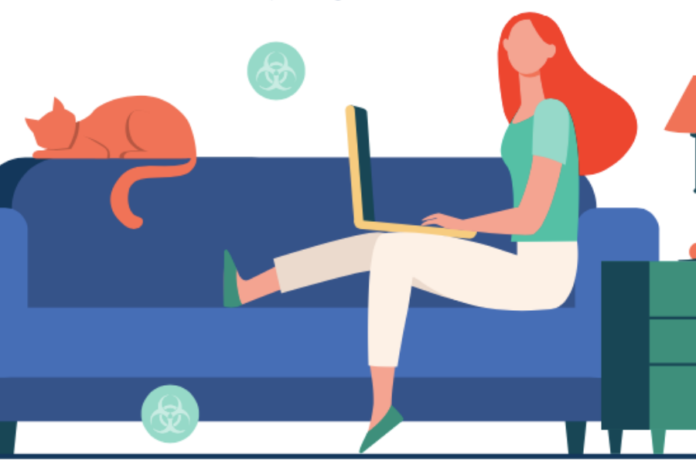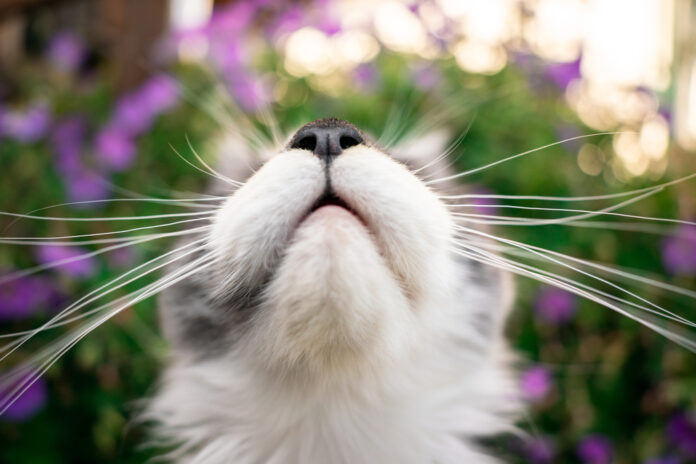Environmental toxins in the home — how to help your cat breathe easier

Our homes contain a range of environmental toxins that can affect your cat’s respiratory system. Here are the most common culprits, and what you can do to help your kitty breathe easier.
Does your cat sneeze a lot? Have you noticed irritated or runny eyes? Perhaps some coughing? Or worse, has she developed chronic bronchitis or asthma? These symptoms may have several causes, one of which could be a sensitivity to environmental toxins in the home. Such sensitivities can appear in cats of any age. This article looks at the most common culprits when it comes
to these toxins, and what you can do to help alleviate your cat’s suffering.
MANMADE CHEMICALS ABOUND
The number of environmental toxins present in our homes has increased steadily since the 1970s. From fire retardants to air fresheners, these chemicals were all originally created to makes our lives easier, safer, or more pleasant. But for some individuals, including our feline companions, they can make life more difficult. Exposure to the chemicals used in fabrics and materials for curtains, rugs, furniture and other household items has resulted in a variety of health problems in both humans and animals. The greater the number, variety, and concentration of manmade chemicals in a household, the greater the chances that your cat (or human family) will suffer from the health effects they can produce.
Food Sensitivities
Although food sensitivities caused by additives in commercial pet foods don’t typically cause respiratory symptoms, they can still contribute to the total chemical burden on your cat’s body. These sensitivities generally cause itchy skin or GI upsets such as vomiting or diarrhea. Switching to a healthier diet is just one more way to help her feel better overall.
HOW TO FIND THE CAUSE OF YOUR CAT’S DISCOMFORT
If your cat develops any of the respiratory symptoms mentioned above, the first step is to take her to the veterinarian for a checkup. Once other health problems, such as an infectious disease, are ruled out, it’s time to start looking at toxins in your home environment, such as the following:
- Is anyone smoking or vaping indoors? The effects of second-hand smoke can be as bad for cats as they are for people. This is especially true of vaping, which was initially promoted as a “healthier” alternative to inhaling tobacco smoke. The solution is to stop smoking or vaping inside the house. This single step can make a big different in a cat’s respiratory health.
- Toxins in the air can also come from the evaporation or “outgassing” of chemicals. Outgassing occurs when chemicals are gradually lost from materials in the home, especially those made from plastics. The result is a weakened product as well as chemicals in the air that you may be unaware of. For example, even if paint looks and feels dry, it can continue to cure or dry further, releasing low levels of toxins. Similarly, commercial floor and furniture waxes contain many compounds that can evaporate and cause sensitivities in your cat.
- High levels of dust mites in the home are associated with an increased number and duration of asthma attacks in humans, and difficulties in breathing. Dust mites can affect cats as well.
HEPA FILTERS AND OTHER SOLUTIONS
What can you do to minimize the impact of environmental toxins in your home, and improve your cat’s health? A HEPA filter can be very helpful, especially one with a charcoal pre-filter. The charcoal absorbs certain gases that the main filter can’t. Many people notice that they, as well as their animal companions, breathe more freely and have less eye irritation after buying a HEPA filter. As a bonus, a HEPA can also help reduce the negative effects of dust mites.
 In addition to purchasing a HEPA filter, start using more natural products such as household cleaners to help everyone — feline and human — breathe better. It’s true that a natural product may require a little more effort to use than chemical household cleaners. For example, when using a beeswax product rather than a chemical furniture polish, you might need to apply more pressure to get a good shine. You might need two products instead of one to clean carpets or drapes, especially if you are just starting to use more natural products. But your cat’s improved well-being (and your own) is worth it!
In addition to purchasing a HEPA filter, start using more natural products such as household cleaners to help everyone — feline and human — breathe better. It’s true that a natural product may require a little more effort to use than chemical household cleaners. For example, when using a beeswax product rather than a chemical furniture polish, you might need to apply more pressure to get a good shine. You might need two products instead of one to clean carpets or drapes, especially if you are just starting to use more natural products. But your cat’s improved well-being (and your own) is worth it!
If your cat suffers from asthma, do not abandon conventional treatment methods. Cats can suffer uncomfortably or even die from a severe asthma attack. As you introduce more natural products into your house, however, you may notice that her attacks are less severe, and don’t happen as often. In fact, with the guidance of your veterinarian, you might even be able to decrease your cat’s medication.
Because our cats are a lot smaller than we are, and often spend more time in the house than we do, they are more likely to develop health problems in response to the many environmental toxins and chemicals found in our homes. If your cat is exhibiting any persistent respiratory symptoms – sneezing, watery eyes, nasal discharge or coughing — have her checked by the vet, and then look for ways to lower her exposure to household toxins by considering a HEPA filter and adopting a more natural lifestyle.



